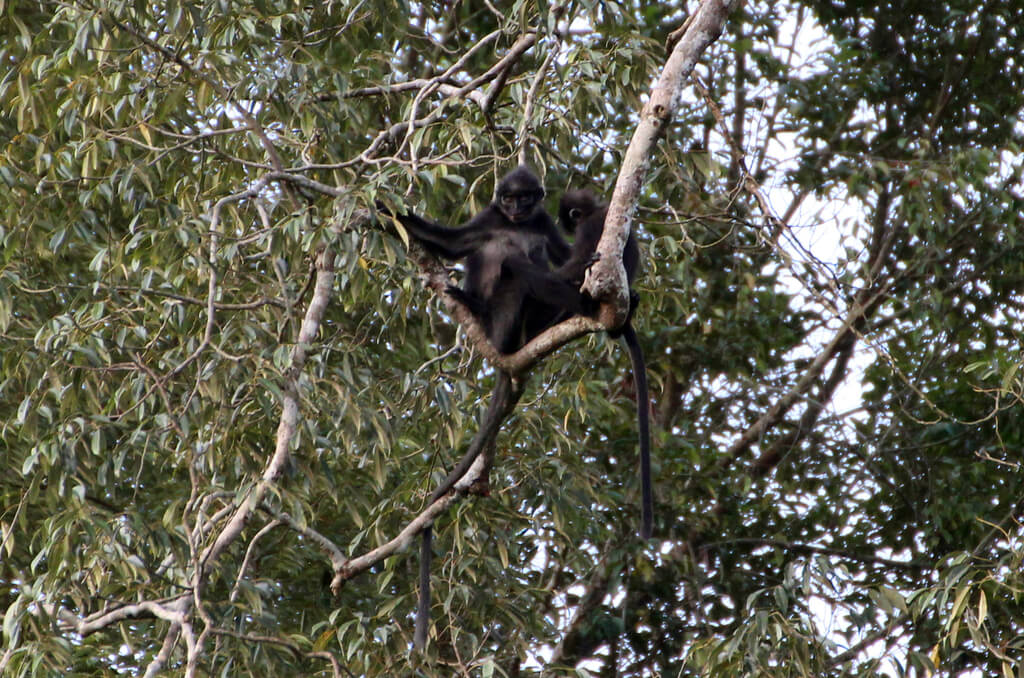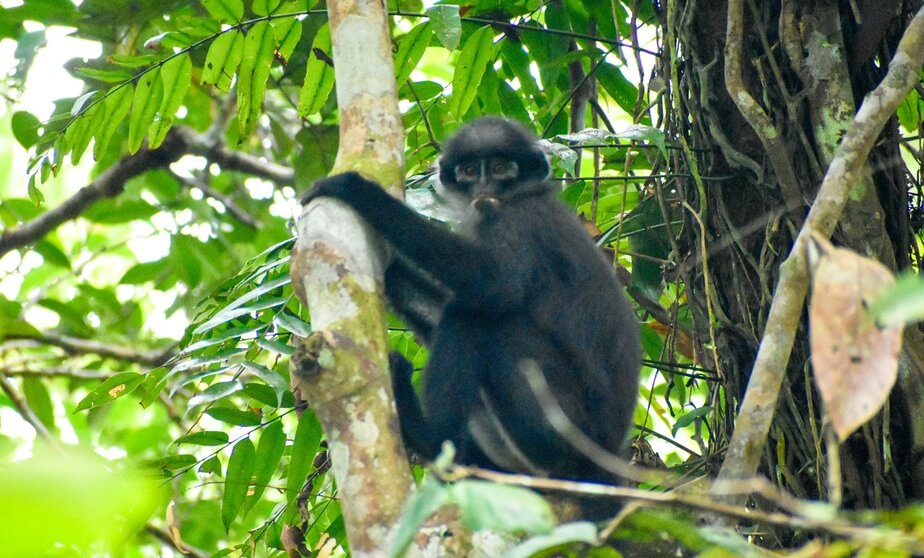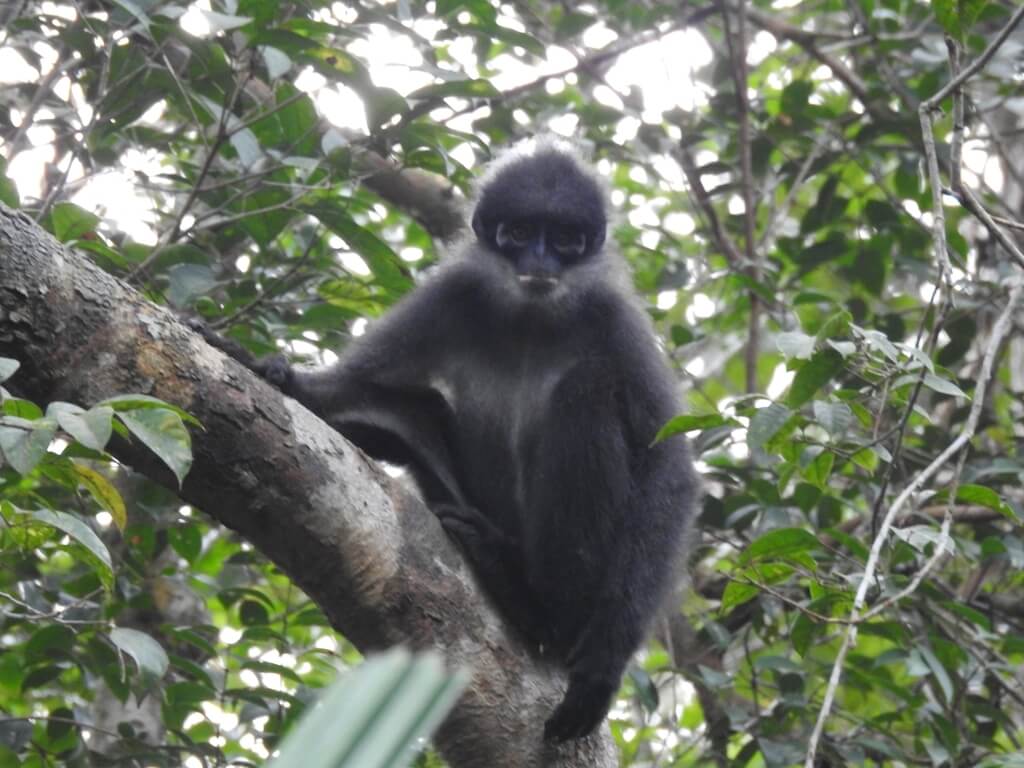September 29, 2025
All over the world, wildlife populations are in decline due to loss of habitat, poaching, and increasing pressure from human development. This makes natural rainforests like Restorasi Ekosistem Riau(RER), an essential habitat for the endemic animals of Indonesia, where they can be studied and protected. One of several endangered species to make their home here is the East Sumatran banded langur (Presbytis percura).
This rare langur species belongs to the family of Old-World monkeys (Cercopithecidae). It is endemic to Riau Province in Sumatra, where langur populations have been in decline due to deforestation and loss of habitat. In 2020, the IUCN Red List declared the species to be Critically Endangered, adding extra importance to conservation for the populations that remain. At RER, we are working tirelessly to safeguard this species.
In this article, we reveal some interesting facts about Presbytis percura, and explore ongoing efforts to restore their habitat. Through collaboration, we’re helping Riau’s remaining langurs bounce back from the brink of extinction.
Primate Species in RER
RER is a sanctuary for many of Indonesia’s endemic animal species. Our most recent biodiversity survey, completed in June 2025, documented 901 species, including 78 mammals, 106 amphibian and reptiles, 319 birds, 207 plants, 89 fish, and 102 odonatas.
RER is home to no fewer than six primates, all of which are on the IUCN Red List:
Many of these primates inhabit the lowland tropical and peat swamp forests of the RER landscape, where they find a refuge from the degradation that has stripped Sumatra’s forests in other locations.
The East Sumatran Banded Langur: Behavior, Diet, and Taxonomy
Until recently, Presbytis percura was considered to be a subspecies of Raffles’ banded langur (Presbytis femoralis), also known as the banded leaf monkey or banded surili. However, scientific studies have now revealed it is a distinct species. It is not yet known how many adult individuals currently remain in the wild.

East Sumatran banded langurs are arboreal and diurnal (meaning they live in forests and are active during the day). They live in primary and secondary lowland and peat swamp forests and are mostly folivorous (meaning they feed on leaves), but also consumes fruits, seeds, and flowers. Our studies have revealed these animals live in small family groups, typically with one adult male, multiple females, and their offspring.
Langurs’ Ecosystem Role in RER
Tropical forests, and especially rainforests, are not flat or uniform habitats. They are structured vertically, like the layers in a cake. Each of these layers have different conditions (eg, light, moisture, food, etc). The main layers include:
In these diverse environments, animals tend to specialize at living in certain layers. The East Sumatran banded langur makes its home in the canopy and upper understory. This vertical niche affects how they move, forage, and interact with other species.

As they feed, forage, and move around, langurs disperse seeds, prune vegetation, and control insect populations, thereby influencing the growth and regeneration of plants in each layer. Consequently, langurs contribute to the structure, balance, and renewal of vertical forest layers — especially in peat swamp forests, where every canopy-level seed dispersed contributes to long-term forest health and carbon storage.
So, by dispersing seeds in their droppings, Presbytis percura support forest regeneration and contribute to the vertical stratification and dynamics of tropical canopy ecosystems.
RER Efforts to Conserve the East Sumatran Banded Langur
Wild populations of Presbytis percura are in serious decline, mainly due to habitat loss from deforestation, logging, and conversion to oil palm plantations. The populations that remain are highly fragmented, with small, isolated groups surviving mostly in lowland forest patches along the east coast of Sumatra – including Riau Province, where RER operates.

Because it was only recognized as a distinct species in recent years, conservation data is still catching up. However, ongoing monitoring efforts, such as those conducted by RER, are helping to fill these gaps in our knowledge and support conservation strategies.
Conservation efforts at RER are best summarized by our PARM approach, comprising Protection, Assessment, Restoration, and Management. Here’s how this approach works in practice:
As one of the rarest primates on Earth, the East Sumatran banded langur is both an emblem of Indonesia’s rich biodiversity and a stark reminder of how quickly species can slip toward extinction. At RER, we believe that with the right blend of knowledge, habitat protection, and local collaboration, even Critically Endangered species like Presbytis percura can bounce back. Through research, restoration, and ongoing conservation work, we’re working to safeguard this species and the vitally important ecosystem it calls home.
For more information on our ongoing reforestation efforts, please visit our website.